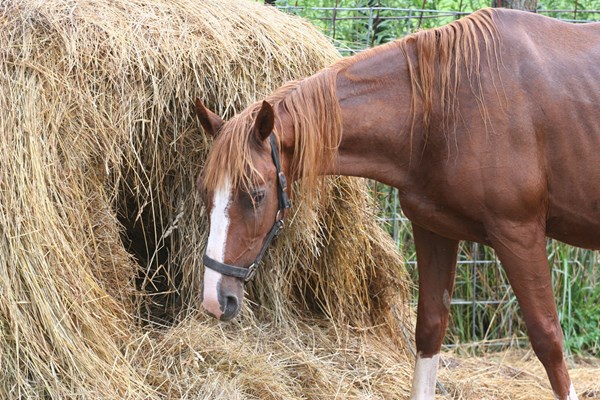 Credit: Thinkstock For those horse owners who feed round bales of hay, how you store the bales can determine how much wastage you face.
Credit: Thinkstock For those horse owners who feed round bales of hay, how you store the bales can determine how much wastage you face.Hay waste can occur during both storage and feeding. Research has shown outdoor hay storage losses of round bales can range from 5% to 35% depending on precipitation, storage site and original condition of the bale. For example, the outer 4″ layer of a 6′ diameter round bale contains about 25% of the total bale volume, and it is most likely to be damaged by weather if stored improperly or unprotected. There are a number of techniques that minimize outdoor storage losses of round bales:
- Bale (or buy) a dense bale as the bales will sag less and have less surface area in contact with the ground.
- Use plastic wrap, net wrap, or plastic twine. Research has shown that net wrapped bales reduced grass hay dry matter losses by 32% compared with twine bales when stored outside.
- Store bales on a well?drained surface. A well?drained, 4 to 6″ coarse rock base will minimize bottom spoilage, as well as using wood pallets.
- Never store round?bales under trees.
- Store round?bales end?to?end when storing outside.
- Position round?bales as tightly as possible in long lines on a well?drained site. If more than one line of bales is needed, space adjacent lines at least 3’ apart. This will increase airflow and allows sunlight to penetrate the bales.
- In a South Dakota study, dry matter losses of round bales were 4% for round?bales stacked individually and less than 1% for round bales stacked end to end.
- When storing round bales outside without cover, never stack round bales in a pyramid. Stacking tends to trap moisture and limits drying action from sunlight and wind.
- A South Dakota study reported dry matter losses of round?bales stacked in pyramids at more than 10% after one year of storage.
- Storage losses are usually reduced by approximately two?thirds with indoor storage and by one?half with good plastic covering (i.e., a tarp) outdoors.
This article was written by Krishona Martinson, PhD, University of Minnesota. You can subscribe to the university’s horse newsletter on this page.


